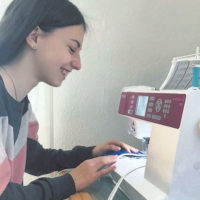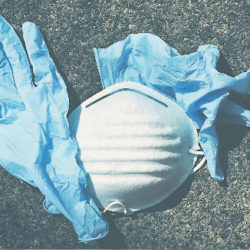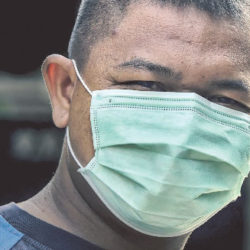Homemade or simple face masks give the wearer a deceptive lack of protection and they do not prevent the spread of the virus. Meanwhile, Chinese factories are doing big business off the back of COVID19. By Ralf Trautwein
Until now, medical protective masks were in short supply in Villingen-Schwenningen during the current corona crisis. This went so far that even patients were donating masks to their doctors, whose supplies were simply used up. Germany has been caught cold by the coronavirus – protective clothing and masks are unavailable where you need them the most. This is due to the fact that such items are mainly manufactured abroad and are currently in great demand all over the world. In Villingen-Schwenningen, the bottleneck has now largely been eliminated – thanks to “One Point Zero” a company co-founded by entrepreneur Eric Voigt. Voigt studied international business administration in Schwenningen and his business partner, Markus Winter, with me today. The two mayors, Jürgen Roth, took great care to ensure that from now on, mask deliveries can regularly arrive in Villingen-Schwenningen. This will primarily benefit medical staff who deal with corona-infected patients. Low filtration or homemade masks are useless for doctors and nurses who need a high quality, face mask with a filter, to effectively protect themselves against infection. The demand is currently immense, from simple mouthguards to medical protective masks. And even if simple masks do not protect against infection with the coronavirus, they are in some cases being auctioned off on the internet at incredibly high prices, taking advantage of people’s fear.
Two Types of Masks in Clinics
Currently, two types of masks are used in clinics: simple surgical masks made of fibre, which are intended to protect patients from the saliva of doctors and nursing staff during an operation, and FFP2 and FFP3 protective masks (filtered respirators). These are made of firmer material and have a breathing valve. The coronavirus particles are very small, and only the FFP masks are constructed so that they cannot get through, experts say. Protective masks with FFP2 protection are particularly popular in the corona crisis. Thanks to the innovative filter technology, breathing resistance remains low, and breathing is not impeded by trapped particles in the filter, even if the respirator is used several times over. There are currently initiatives on social media to curb the spread of the corona virus through self-made protective masks. There are numerous videos and instructions on the internet for this purpose. Private and publicly organized groups produce so-called makeshift mouth-nasal protective masks in large quantities, specifically in the distribution area of NECKARQUELLE (we reported).
Self-Made Masks Allow 700 Times More Virus Through
Anyone who wears such a self-made face mask should not feel too safe: According to a recent study, an FFP2 mask only allowed 0.12 percent of the particles to pass through, whereas with DIY masks that were made from cotton, 74 to 90 percent passed through. If you wear such a mask for your own protection, you inhale about 700 times more virus than with a professional respirator.
Experts agree that a self-made mask can only serve to significantly reduce the droplet flight in the exhaled air of the mask wearer meaning that they are not completely useless when it comes to blocking infection routes. An already unknowingly infected person wearing a self-made mask can at least reduce the risk to other people. By wearing them in nursing homes, supermarkets and on public transport, you can at least offer a certain security to those around you.

Many are currently using the sewing machine and making face masks themselves. However, they cannot protect their wearer from corona infection. This requires professional masks with an integrated filter.
Staying Away is the Best Precaution
For this reason, debates about a general mask requirement, as was held regionally, are pretty pointless. In the open air, the risk of infection is negligible as long as you keep your distance: Keeping a good distance is the best way to keep yourself healthy at the moment. People with pre-existing conditions are well advised to get a professional protective mask with a respiratory filter. But here, too, it is important to observe safety rules as wearing a mouth-nose mask can actually be dangerous if you use them incorrectly. Improper use does occur as many people who often use the mask, do not check or adjust their fit.
Wearing a Mask Correctly
Often you can see people putting their mask under their chin when they are not around people and pull it in front of their face again in a supposed “dangerous situation”. This is counter-productive, because you can catch the coronavirus with a smear infection. You should act as you would normally if you were not wearing a mask and should not touch it until you are safe to remove it. Always wash your hands after removal. Where, in the past few weeks German companies have started mask production out of necessity, the FFP masks have always been made on a large scale in China. There are now 110 million masks being manufactured a day, compared to only 20 million in early February. 3000 factories are said to be creating masks, including corporations like BYD, the market leader in electric cars, and Foxconn, a well-known company that otherwise produces for Apple. Observers assume that China’s mask production will increase tenfold this year compared to 2019. A bitter insight from this situation at the moment is that Europe can hardly protect itself without China. Shopping in China is not that easy, even in a globalized world. You have to know the companies, suppliers and processes in China. The order is processed mainly through purchasing agencies that do business in China. Anyone who orders there must be familiar with DIN standards and protection classes, but many customers lack the specialist knowledge and the ability to check the quality of the goods, as Villingen-Schwenningen is now doing with “OnePointZero” on site.

The organization chart of the globally operating “OnePointZero“, the company with which Eric Voigt (third from right) is effective in the crisis, providing protective masks for Villingen-Schwenningen. Markus Winter (center) is representative of the know-how company in Germany. The team of 40 (on the right) in Hong Kong ensures the best quality for German customers.
If you order thousands of masks without prior knowledge of ordering in Asia, you may end up with inferior product or in the worst case – no product at all. Municipalities as corporations under public law also face another insurmountable hurdle: for legal reasons, they cannot make an advance payment. However, this is what the Chinese insist on as they want at least 50 percent in advance, many even require the full purchase price. For this reason, cities and districts, like VS and the Schwarzwald-Baar district, that have to equip their clinics, are currently mostly dependent on commercial agencies. Few are as lucky as Villingen-Schwenningen, who have such good contacts. There are dealers from the Middle East who ordered 900 million masks through China and a fully utilized production process was put in place. A German city administration, however, has little chance of this.
Different Prices Every Day
Because demand is currently booming, the Chinese are changing their prices practically every day. Before the corona crisis, simple mouth-nose protection, without a protection class, cost about five cents each. Now, we are at a price of 50 cents each, sometimes even more. Manufacturers are already making money on masks without the increased price, because after all, they are disposable products. The masks must be disposed of after a few hours, otherwise they will no longer effectively protect wearer.



